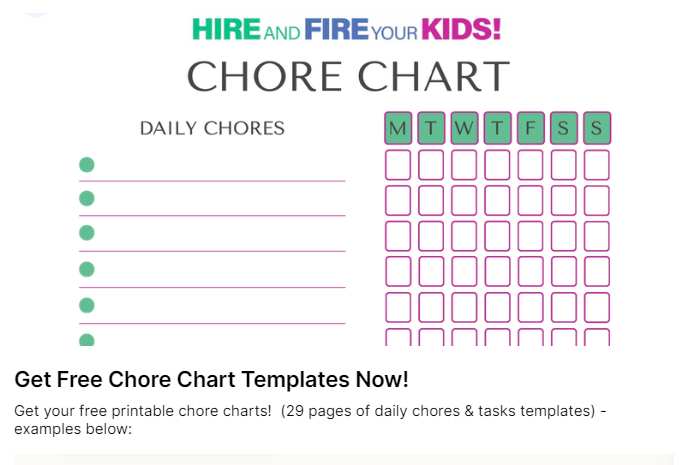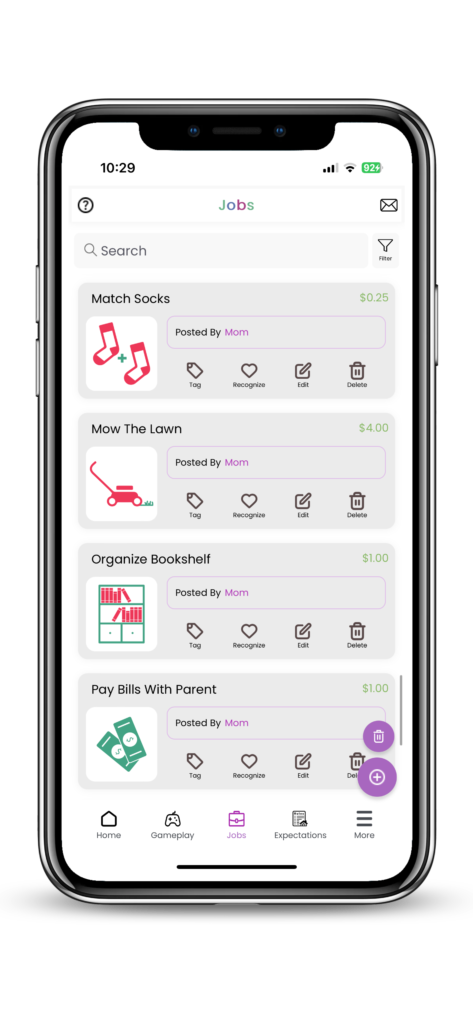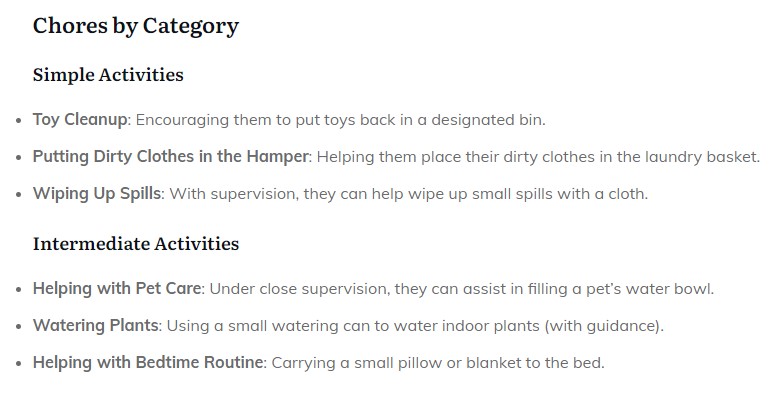Coming up with a fair chore pay scale for your kid’s chores can feel a little like trying to determine the value of miniature Picassos – subjective, complicated, and with plenty of room for debate. Who knew so many complexities could play a role in determining the worth of a cleaned room or a mowed lawn?
In the ballpark of child-rearing, wrestling with these questions is a common, yet daunting encounter. But what if you could demystify the art of setting up a reasonable chore pay scale, eluding tantrums and encouraging a healthy work-to-reward mindset among your little artists (or gardeners, or laundry champions)?
You’re about to decode a guide that promises to steer you through this labyrinth with ease, just as effortlessly as you’d navigate through your regular grocery store.
Brace yourself: it’s time to chalk out a masterful blueprint to the not-so-mysterious after all – Chore Pay Scale!
Understanding the Chore Pay Scale: A Comprehensive Guide
- A chore pay scale is a dynamic tool for teaching children financial responsibility
- Creating a personalized chore pay scale can aid in fostering positive financial habits from a young age
- Different chore pay scales can fit various family dynamics and child age groups
What is a Chore Pay Scale?
A ‘chore pay scale’ is a systematic way of determining how much allowance kids receive in exchange for completing household tasks. It acts as a financial learning platform for children, introducing them to concepts like earning, saving, and budgeting while teaching them responsibility.
The purpose of implementing a chore pay scale in a household is multifaceted. Primarily, it seeks to appraise the value of work, fostering an understanding that effort garners reward. Moreover, such a scale aids in instilling the virtues of responsibility and financial prudence in children from an early age. Notably, the system can also introduce children to the very real adult concept of pay disparity, demonstrating that not all tasks are valued equally.
Remember, while the primary objective of a chore pay scale might be to teach children valuable financial lessons, it’s not just about the money. It’s equally about developing life skills, independence, and a sense of duty.
How to Set Up a Chore Pay Scale
Establishing a chore pay scale involves a multi-step process that requires careful planning and consideration. Here is a simple guide to help you begin:
- Discuss as a family: Start by having an open conversation with your children about the purpose of a chore pay scale. Define the concept of ‘earning’ and ensure your children understand why you’re implementing this new system.
- Catalogue the chores: Take note of all the tasks that need to be done around the house. Divide these tasks based on difficulty levels, assigning each chore a points value.
- Decide on a currency: Determine how much one ‘point’ is worth in terms of allowance. You might want to consider that smaller, simpler tasks are worth a few cents, while larger, more complex chores earn the kids a few dollars. This can be adjusted as the children age or as they become more adept at their tasks.
- Implement the scale: Once decided, put the scale into effect. Make sure it is visible (perhaps on a fridge or a notice board) and understood by all.
There are multiple ways to structure a chore pay scale, depending on the age, maturity, and independence of your children. For example, younger children might have a simple chore list where they get a set amount of allowance for each task. In contrast, older children may benefit from a more complex pay scale, where they earn varying amounts of allowance based on the chore’s difficulty and length.
Pay scales can also differ based on specific family needs and values. For instance, some families might choose not to pay for personal chores (like making a bed or cleaning a room), but offer compensation for helping with common household tasks. Others may decide to offer bonus payments for completing additional chores or executing a job well.
In essence, creating a chore pay scale paves the way for children’s financial prudence and hard work. It’s a journey that goes far beyond mere monetary gain, enriching their overall personality and life skills. With a customized chore pay scale, your children will be well on their way to understanding the fundamentals of financial responsibility.
Chore Allowance by Age: How Much Should You Pay?
- Age-specific chores come with their respective pay. Balancing chores and pay can help kids understand the work-to-reward dynamics.
- Several factors, such as the complexity of the task, time taken, and the child’s age, influence the chore pay rate.
Age-Appropriate Chores for Kids and Their Corresponding Pay
Children of varying ages can handle different tasks, guiding parents on suitable chore allocation. For instance, younger children, let’s say five years old, can be assigned lighter chores like making their beds, organizing toys, or feeding pets. For such tasks, a sensible range might be $1 to $2 per chore.
For slightly older children, say nine to twelve years, their chores could be a level up, such as helping in meal preparation, vacuuming, or yard work. The corresponding pay for these chores could be in the range of $3 to $5, but this entirely depends on the household and personal financial circumstances.
Teenagers can handle even more complex tasks around the house, such as washing cars, babysitting younger siblings, or assisting in substantial home projects. Such help could be rewarded with higher pay, let’s say $7 to $10 per task, again subject to the discretion of parents.
If you want to get the complete and comprehensive guide to age-appropriate chores for kids, check this out:

Chores for Kids: The 2024 Age-Appropriate List
Creating a fair and structured chore pay scale for kids can be a practical way to teach them about financial responsibility while recognizing their contributions to household tasks. Here’s a chore pay scale that varies by the complexity of the chores and the age of the children, which you can tailor to fit your family dynamics and financial principles.
Chore Pay Scale for Kids
| Age Group | Chores | Pay per Chore |
|---|---|---|
| 5-8 years | Making bed, organizing toys | $1 – $2 |
| Feeding pets | $1.50 | |
| 9-12 years | Vacuuming, helping with meals | $3 – $5 |
| Yard work (simple) | $4 | |
| 13-15 years | Washing car, babysitting | $7 – $10 |
| Assisting in home projects | $8 – $10 | |
| 16+ years | Managing family budgeting tasks | $10 – $15 |
| Major landscaping work | $12 – $15 |
Factors to Consider When Determining Chore Pay
- Complexity and Skill Required: More complex and skill-intensive chores should command higher pay to reflect the effort and responsibility involved.
- Time Commitment: Chores that take more time should also be compensated at a higher rate.
- Age Appropriateness: Ensure the chores are appropriate for the child’s age and capabilities, adjusting the pay scale as they grow and take on more complex tasks.
Benefits of Using a Chore Pay Scale
- Teaches Financial Responsibility: Kids learn that money is earned and not just given. They learn Allowance Management, teaching them to manage their allowances and understand the value of money.
- Encourages Work Ethic: Associating effort with reward can motivate children to be more helpful and take initiative. This is how they develop a strong work ethic.
- Financial Literacy: Introduces basic concepts of budgeting, saving, and spending responsibly. This is how they learn financial literacy.

Tips for Implementing the Chore Pay Scale
- Discuss the System Openly: Make sure children understand how the pay scale works and the rationale behind the differing rates for different chores.
- Be Consistent: Apply the pay scale consistently to avoid confusion and ensure fairness.
- Adjust as Needed: Periodically review and adjust the pay scale as children grow older or as their competencies improve.
By integrating these practices into your family’s routine, you create a robust framework for teaching children the value of hard work and money management from an early age. This not only helps in building responsible adults but also in fostering a strong work ethic and financial independence.
Factors to Consider When Determining Chore Pay
When setting the allowance for each task, various elements come into play. One significant factor is the level of complexity associated with each chore. Tasks that require a more considerable effort or skill demand a higher pay rate. Time is also vital; chores that take more time should come with better pay.
The child’s age ties in with these factors. Younger kids, who are assigned less complicated and less time-consuming chores, earn less compared to older kids who handle more complex tasks. It’s fair to balance the chore pay in this sense, as it mirrors real-world remuneration principles.
Moreover, creating this kind of chore pay scale can foster an understanding of work ethics, promoting a value system where harder and longer work is rewarded with higher pay.
With these principles, you can not only teach your kids the importance of hard work and financial planning but also ensure fair remuneration for their efforts.
Using a Chores for Money Chart: A Visual Guide to Chore Pay
- Advantages of chore visuals
- Step-by-step creation guide
Benefits of Using a Chores for Money Chart
A chores for money chart can revolutionize how you deal with kids and their chores. Through visualization, it aids in reducing disputes about chore payment, clarifies expectations, and provides a tangible trail of a job well done.
Primarily, it establishes clarity and transparency. A well-constructed, easily visible chore chart cuts down on chore disputes. Having prices visible reduces the scope for negotiation, presenting a “What you see is what you get” scenario.
Second, it sets expectations. By displaying chore valuation, children understand what each task is worth, prompting them to prioritize tasks based on their monetary value.
Lastly, it provides immediate satisfaction for a job well done. The act of marking off a completed task can produce feelings of achievement and motivation in a child, driving them to complete more chores. The Hire and Fire your Kids app does this job very visually.

How to Create a Chores for Money Chart
Creating a chores for money chart can be an engaging and educational activity. Here is a step-by-step guide:
Step 1: Identify the chores. Look around your house and your daily routine and jot down all the chores that you think your child can handle safely and efficiently.
Step 2: Next, assign a monetary value to each chore. This can be based on factors such as the complexity of the chore, the time it requires and the level of responsibility involved.
Step 3: Create the chart. This can be a simple chart on paper, a whiteboard, or even digitally on a tablet. The chart should include the description of the chore, its monetary value, and a space where the child can mark off the chore when completed.
Step 4: Review and adjust. Regularly review the chart with your child, adjust values if needed, and add or subtract chores based on your child’s capacity and interest.
This meticulously created visual guide not only systematizes chore payment but also serves as a practical tool for teaching children about monetary value, prioritization, and accountability.
These factors play a significant role in shaping children’s understanding of financial responsibility, an essential life skill.
Sample Chores for Money Chart
Here’s a sample chart that you can use as a template:
| Chore | Description | Age Group | Pay | Done (✔) |
|---|---|---|---|---|
| Make Bed | Make your bed every morning | 5-8 years | $1 | [ ] |
| Clean Room | Tidy up the room and put toys away | 5-8 years | $1.50 | [ ] |
| Take Out Trash | Take out kitchen trash | 9-12 years | $2 | [ ] |
| Vacuum Living Room | Use the vacuum in the living room area | 9-12 years | $3 | [ ] |
| Yard Work | Help with weeding or raking leaves | 13-15 years | $5 | [ ] |
| Wash Car | Wash the family car outside | 16+ years | $10 | [ ] |
| Babysit Younger Siblings | Watch younger siblings for 2 hours | 16+ years | $15 | [ ] |
Or, you can grab this free download of our HFK chore chart:

Tips for Using the Chart
- Encourage Regular Participation: Use incentives like bonus payments for consistent completion of chores or for taking initiative beyond the listed tasks.
- Visual Motivation: Consider using stickers or markers that children enjoy to mark completed tasks, making the process fun and engaging.
- Flexibility: Adjust the chores and payments as children grow older and their abilities increase, keeping them motivated and challenged.
This “Chores for Money Chart” acts not only as a tool for managing household tasks but also serves as an educational resource to teach kids about work ethics, financial management, and the value of money.
If you want to take the chore chart a step further, the Hire and Fire your Kids app allows you to post chores with a corresponding reward in dollars or points. Your children can then apply for the job to earn the rewards.
How to Manage Chores with Hire and Fire your Kids: A Step-by-Step Guide
If you’d like to upgrade your chore management operation from paper to digital, I can help. It’s what I use. Managing chores can be seamless with the Hire and Fire Your Kids app where your kids can learn through play. Here’s how to get started:
- Download and Set Up the App: Download the app and create profiles for each child.
- Assign Chores: Use the app to assign age-appropriate chores and set deadlines. Or, your kids can “apply for jobs” and assign themselves.
- Track Progress: Monitor their progress through the app and provide feedback. Give out warnings or recognition as needed.
- Incentivize with Rewards: Set up and customize a reward system that motivates your child to complete chores on time. Use KidsKash to pay them out for the money they earn with their chores.
- Review and Adjust: Regularly review chore assignments and adjust based on your child’s growth and performance.

Implementing an Allowance System for Kids: Teaching Financial Responsibility
- Understanding the role an effective allowance system plays in teaching kids financial responsibility
- Insightful tips for setting up a beneficial allowance system
- Savvy ways of showing kids how to manage their finances
The Role of an Allowance System in Teaching Financial Responsibility
Teaching our children financial responsibility is no small task. Often, it’s not just about teaching them what money is and how it works, but also instilling in them the values of earning, saving, and spending wisely.
An allowance system is more than just paying kids for the chores they do. It serves as a versatile tool for teaching kids about money management. It demonstrates how the real world functions – earning comes after work. Thus, an allowance system can shape their understanding of the financial world early on.
Consider this, from the moment children receive their allowances, they’re faced with cost-benefit analysis questions: “Should I buy this toy now, or save more to get the bigger one later?” “Is buying a soda worth skipping snacks later?” These decision-making situations, though minor, pave the way for understanding budgets, savings, and economic trade-offs.
Tips for Implementing an Effective Allowance System
Implementing an effective allowance system is not as simple as it sounds. It requires planning and consistency. Here are some tips to make this task less daunting and keep the kids motivated.
Commence with setting clear, achievable tasks for kids to earn their allowances. Tasks can range from doing household chores to getting good grades at school – the idea is to illustrate the correlation between effort, work, and financial gain.
Transparency in the system is essential. Make sure your kids understand the pay scale for various chores – this not only eliminates confusion but also helps them prioritize tasks based on their goals.
Set a specific payday. A fixed pay day introduces them to the concept of the ‘paycheck to paycheck’ life. It also keeps them motivated and instills patience as they wait for payday to arrive.
Finally, encourage the habit of saving. Teach them that saving doesn’t equate to not using money but waiting to use it for something substantial. Introduce the concept of short-term and long-term saving goals. They could save up for a toy they want or a bike they’ve been eyeing for a while; the incentive here lies in the goal.
Overall, introducing an allowance system can be instrumental in teaching kids about the value of money, the importance of earning, saving, and thoughtful spending. It’s a practice that will set them up for a better understanding of the financial world as they grow.
The Cost of Chores in America
- How chore pay is determined in the United States
- Learn about the variables that drive chore costs in disparate regions
Chore Pay Across America
Lots of parents agree that rewarding children for chores teaches them responsibility and the value of money. But how is the pay for these chores determined across America?
Some choose to base pay according to the task. Simple chores like picking up toys or feeding pets are suited to younger children so $0.50 to $2 per chore might be appropriate. As they get older and the complexity of their chores escalates – from vacuum cleaning to washing dishes – older kids might earn between $1.50 and $3 per chore. While teenagers, carrying out more labor-intensive chores like mowing the lawn or washing the car, might expect anywhere from $5 to $10 per task.
Others choose to have a set weekly payment and base this on the child’s age rather than the tasks themselves. A commonly used starting point is $1-2 per year of age each week. So a 5-year old would earn $5-10 per week and a 10 year old would earn $10-20. Rather than paying an amount for each chore, parents might set each child a list of jobs to be completed in order to receive the weekly allowance. This option is equivalent to adults in the working world receiving a yearly salary rather than an hourly rate.
Here’s a chart that compares different payment strategies for children’s chores across America. This table presents an overview of how chore pay varies based on the task, age, and other factors:
| Age Group | Chore Examples | Pay per Chore | Weekly Allowance Based on Age | Comments |
|---|---|---|---|---|
| Young Children (Under 10) | Picking up toys, feeding pets | $0.50 – $2 | $1-2 per year of age (e.g., 5 years old = $5-10 per week) | Simple tasks suited to younger children; weekly allowance reflects age rather than specific tasks completed. |
| Pre-Teens (10-12 years) | Vacuuming, washing dishes | $1.50 – $3 | $10-20 per week (10 years old) | Increasing complexity of chores with age, pay per chore increases. |
| Teenagers (13+ years) | Mowing the lawn, washing the car | $5 – $10 | Based on negotiation or specific family guidelines | Labor-intensive chores warrant higher pay, recognizing greater effort and responsibility. |
Additional Notes:
- Variability Across Households: The pay rates for chores can vary significantly depending on the household’s financial situation, the regional cost of living, and the parents’ philosophy on chore compensation.
- Adjustments for Complexity and Skill: As children age and their competence increases, so does the complexity of the chores they are assigned, along with appropriate adjustments in their compensation.
- Set Weekly Payments vs. Pay Per Chore: Some families prefer a structured weekly allowance that encourages routine and responsibility over earning per chore, which can help simulate a salary-like experience.
This table provides a structured way to view how chore compensation is typically handled in different American households, reflecting a range of factors including the child’s age, the chore complexity, and the chosen method of payment.
The amount parents pay their kids for chores varies significantly across households. In addition to age, the complexity of chores, children’s competence, and parents’ financial capacity all play a part in determining the chore pay scale.
Factors Influencing the Cost of Chores in Different Regions
While the chores themselves might be similar across American homes, several factors come into play when deciding how much children should be paid for their labor. Just like the working world, where location can significantly influence income, so does the world of children’s chores.
States with a higher cost of living, such as New York and California, often have parents paying more for their kids’ chores compared to states like Mississippi or Oklahoma, with lower living costs. But it isn’t just about location. Culture, economic status, and family values also shape the price tag on chore payments.
For instance, families with stronger traditional views around household duties may assign chores as part of the child’s contribution to the family unit, attributing less monetary value to their tasks. This contrasts with families that see chores as an opportunity to encourage financial literacy and pay a higher amount to their children. Therefore, region-specific factors like these drastically impact chore pay scales across the country.
So, while chore pay in the U.S. is not standardized across regions, knowing these influencing factors and how others determine pay can guide you in deciding a fair amount to encourage your child’s participation in chores.
Guide to Allowances for Kids: How to Nurture Financially Savvy Kids
- Becoming money-smart begins in childhood
- Learning how money works and how to handle it responsibly is essential for future financial stability
- Avoid common errors that parents often make when introducing a chore pay scale
The Importance of Teaching Kids About Allowances
Teaching a child about allowances isn’t just about handing over a few dollars when they’ve finished their chores; it’s about preparing them for a financially secure future. Just as you wouldn’t let a child drive without teaching them road safety, it’s best to equip them with the tools to safely navigate the financial highways of life before they leave the nest.
Allowances allow children to experience hands-on money management early on. They learn there’s more to money than simply spending it; it has to be worked for, wisely managed, possibly saved, and appropriately spent. Understanding the value of money and the effort required to earn it is a key life lesson that ideally begins at a young age.
Strategies for Teaching Kids About Allowances
To effectively teach kids about allowances, consistency and clarity are crucial. Start by establishing a clear system for earning and receiving allowances. Link their work (chores) to their pay and make sure they understand this process. For example, if they fail to complete a chore, help them understand it will impact their allowance.
Another strategy is to let them make decisions, including mistakes, with their money. It may be hard to watch them spend all their allowance on a not-so-worthy purchase, but it’s better to let them learn this hard lesson early when the stakes are low.
Consider using visual aids like money jars labeled ‘spend’, ‘save’, and ‘donate’. This physical representation of money management can be powerful, especially for younger children.
Common Mistakes to Avoid When Implementing a Chore Pay Scale
When it comes to implementing a chore pay scale, avoid over-complicating things. Keep it simple. The process should be easily understood by your kids. If they have to navigate a complex system just to figure out what they’re earning or losing, they’re more likely to disengage.
Don’t make the mistake of undervaluing or overvaluing chores. Paying your child an unrealistic amount for household chores might not be economically feasible, and can also create false expectations about work in the real world.
Finally, consistency is key. Ensure once you’ve set up a system, you stick to it. If kids see that the rules can be bent or broken, they won’t take it seriously. Reinforce the correlation between work and reward consistently, and you’ll set your kids up for a better understanding of how the world operates.
Bringing It All Back Home: Fair Chore Pay for Your Kids
Determining a fair chore pay scale doesn’t have to be a minefield. By factoring in things such as age appropriateness, time invested, and impact of the chore, you can create a system that’s fair, teaches fiscal responsibility and still within your budget.
This guide aims not just at fostering a sense of responsibility but also nurturing financially literate children who understand the value of money.
Your next step? Jot down a list of chores around your home and begin assigning values using the factors mentioned. Every household is different, so what works for others might need a tweak for you.
To gauge your success, ask yourself this: Are your kids understanding the relationship between hard work and reward? Are they learning about saving and making wise financial decisions? If yes, you can pat yourself on the back.
Because when the day ends, this is more than just about establishing a fair chore pay scale. It’s about equipping our children with the right mindset and tools to survive in an increasingly complex financial world. Now, isn’t that a home run?
Next Steps
Ready to get started?
Download the Hire and Fire Your Kids app today and see how fun chores can be!



